Theridiidae
Cobweb spiders
Jeremy Miller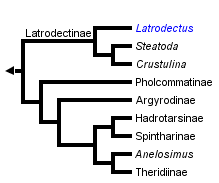


This tree diagram shows the relationships between several groups of organisms.
The root of the current tree connects the organisms featured in this tree to their containing group and the rest of the Tree of Life. The basal branching point in the tree represents the ancestor of the other groups in the tree. This ancestor diversified over time into several descendent subgroups, which are represented as internal nodes and terminal taxa to the right.

You can click on the root to travel down the Tree of Life all the way to the root of all Life, and you can click on the names of descendent subgroups to travel up the Tree of Life all the way to individual species.
For more information on ToL tree formatting, please see Interpreting the Tree or Classification. To learn more about phylogenetic trees, please visit our Phylogenetic Biology pages.
close boxIntroduction
Cobweb spiders (Theridiidae) are one of the most diverse spider families, not only in terms of species numbers (>2200 described and many undescribed species), but also for the range of behavior, ecology, and morphology represented within the group. Theridiids include the widow spiders (genus Latrodectus), known for their potent venom and sexual cannibalism (females of some species typically eat the males during or shortly after mating). Sexual cannibalism is actually much more common in Tidarren and Echinotheridion, two genera where juvenile males amputate one of their two pedipalps (sperm transfer organs). Like Latrodectus, Tidarren and Echinotheridion have females much larger than males, a phenomenon known as sexual size dimorphism. Theridiids also include the majority of social spider species, which live in large colonies composed mostly of juvenile and adult females that cooperate in hunting, web building, and brood care. They include the largest group of kleptoparasitic spiders, which steel prey from other species.
Characteristics
Theridiid spiders have a comb of serrated setae on the fourth tarsus. Similar combs can also be found in some related families (Nesticidae, Synotaxidae). The combs are used to throw sticky silk over prey. Theridiids may wrap their prey in silk before applying a poisonous bite (wrap attack), or bite first. The wrap attack allows theridiids to delay direct contact with prey until it is safely immobilized. The sticky silk used in the wrap attack comes from large, specially modified silk spigots that are uniquely elongate.

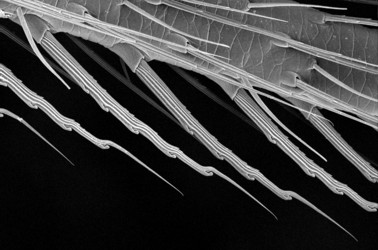
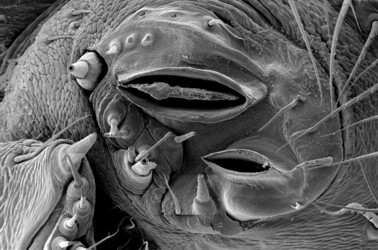
Left (top): Comb of serrated setae on fourth tarsus of a Thwaitesia female. Right (bottom): Spinnerets of an adult Latrodectus hesperus female. Note the elongate silk spigots. Images © Jeremy Miller
Most theridiids have a stridulatory (sound producing) organ where elevated setal bases on the front of the abdomen rub against ridges on the back of the carapace. These organs are often more strongly developed in males. During courtship, males signal females with stridulatory sounds and other vibrations; in some species, females signal back.
Theridiid webs are extremely variable but typically consist of a three dimensional mesh with gumfoot lines. Gumfoot lines are under tension and adorned with sticky droplets. Similar webs are made by nesticids. In some theridiids, the mesh part of the web may be a broad sheet or nearly spherical with gumfoot lines radiating out. Gumfoot lines and even sticky silk are absent from some theridiid webs. Some theridiid webs are reduced to a few lines. Hadrotarsines apparently do not build webs.
Discussion of Phylogenetic Relationships
Despite major advances in the past few years, theridiid phylogeny is still a work in progress. Recent studies have analyzed data from morphology (Agnarsson, 2004), molecules (Arnedo et al., 2004), and both in combination (Agnarsson, 2006). These studies largely agree on the composition of subfamilies. The phylogenetic hypothesis illustrated above is simplified from Agnarsson (2006), the only published study combining molecular and morphological data.
References
Agnarsson, I. 2004. Morphological phylogeny of cobweb spiders and their relatives (Araneae, Araneoidea, Theridiidae). Zool. J. Linnean Soc. 141:447-626.
Agnarsson, I. 2006. Phylogenetic placement of Echinotheridion (Araneae: Theridiidae) - do male sexual organ removal, emasculation, and sexual cannibalism in Echinotheridion and Tidarren represent evolutionary replicas? Invertebr. Syst. 20:415-429.
Arnedo, M. A., J. A. Coddington, I. Agnarsson, and R. G. Gillespie. 2004. From a comb to a tree: Phylogenetic relationships of the comb-footed spiders (Araneae, Theridiidae) inferred from nuclear and mitochondrial genes. Mol. Phy. Evol. 31:225-245.
Dippenaar-Schoeman, A. S., and R. Jocqué. 1997. African Spiders. An Identification Manual. Plant Protection Research Instute, Handbook No. 9, Pretoria.
Foelix, R. F. 1996. Biology of Spiders. Second Edition. Oxford University Press, New York.
Forster, R. R., N. I. Platnick, and J. A. Coddington. 1990. A proposal and review of the spider family Synotaxidae (Araneae, Araneoidea), with notes on theridiid interrelationships. Bull. American Mus. Nat. Hist. 193:1-116.
Jocqué, R., and A. S. Dippenaar-Schoeman. 2006. Spider Families of the World. Royal Museum for Central Africa, Tervuren.
Knoflach, B. 2004. Diversity in the copulatory behaviour of comb-footed spiders (Araneae, Theridiidae). Denisia 12:161-256.
Levi, H. W. 2005. Theridiidae. Pages 235-243 in Spiders of North America: An Identification Manual (D. Ubick, P. Paquin, C. E. Cushing, and V. Roth, eds.). American Arachnological Society.
Levi, H. W., and L. R. Levi. 1962. The genera of the spider family Theridiidae. Bull. Mus. Comp. Zool. 127:1-71.
Platnick, N.I. 2006. The World Spider Catalog, Version 7.0. http://research.amnh.org/entomology/spiders/catalog/INTRO1.html.
Information on the Internet
- Interactive Key to the World Genera of Cobweb Spiders (Theridiidae) by Ingi Agnarsson. This comprehensive key to theridiid genera was developed using LUCID BUILDER and requires the LUCID PLAYER (available from www.lucidcentral.com/lucid2/player/lucidplayer.htm). LUCID PLAYER software is free but registration is required. Also, an internet connection is required to make use of the images.
Title Illustrations

| Scientific Name | Achaearanea tepidariorum |
|---|---|
| Location | Asbury Grove, Massachusetts, USA |
| Specimen Condition | Live Specimen |
| Source | Achaearanea tepidariorum - Common house spider with prey |
| Source Collection | Flickr |
| Image Use |
 This media file is licensed under the Creative Commons Attribution-NonCommercial-ShareAlike License - Version 2.0. This media file is licensed under the Creative Commons Attribution-NonCommercial-ShareAlike License - Version 2.0.
|
| Copyright | © 2006 Glen Peterson |
| Scientific Name | Latrodectus hesperus |
|---|---|
| Specimen Condition | Live Specimen |
| Source | Waiting for Dinner |
| Source Collection | Flickr |
| Image Use |
 This media file is licensed under the Creative Commons Attribution-NonCommercial-NoDerivs License - Version 2.0. This media file is licensed under the Creative Commons Attribution-NonCommercial-NoDerivs License - Version 2.0.
|
| Copyright | © 2006 Don Van Dyke |
About This Page

Nationaal Natuurhistorisch Museum Naturalis, Leiden, The Netherlands
Correspondence regarding this page should be directed to Jeremy Miller at
Page copyright © 2006
 Page: Tree of Life
Theridiidae. Cobweb spiders.
Authored by
Jeremy Miller.
The TEXT of this page is licensed under the
Creative Commons Attribution License - Version 3.0. Note that images and other media
featured on this page are each governed by their own license, and they may or may not be available
for reuse. Click on an image or a media link to access the media data window, which provides the
relevant licensing information. For the general terms and conditions of ToL material reuse and
redistribution, please see the Tree of Life Copyright
Policies.
Page: Tree of Life
Theridiidae. Cobweb spiders.
Authored by
Jeremy Miller.
The TEXT of this page is licensed under the
Creative Commons Attribution License - Version 3.0. Note that images and other media
featured on this page are each governed by their own license, and they may or may not be available
for reuse. Click on an image or a media link to access the media data window, which provides the
relevant licensing information. For the general terms and conditions of ToL material reuse and
redistribution, please see the Tree of Life Copyright
Policies.
- First online 08 January 2007
- Content changed 08 January 2007
Citing this page:
Miller, Jeremy. 2007. Theridiidae. Cobweb spiders. Version 08 January 2007 (under construction). http://tolweb.org/Theridiidae/2797/2007.01.08 in The Tree of Life Web Project, http://tolweb.org/





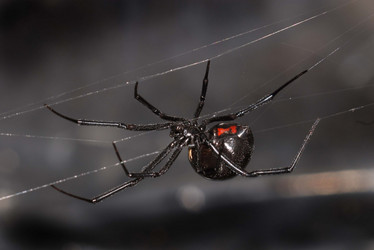
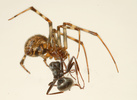


 Go to quick links
Go to quick search
Go to navigation for this section of the ToL site
Go to detailed links for the ToL site
Go to quick links
Go to quick search
Go to navigation for this section of the ToL site
Go to detailed links for the ToL site